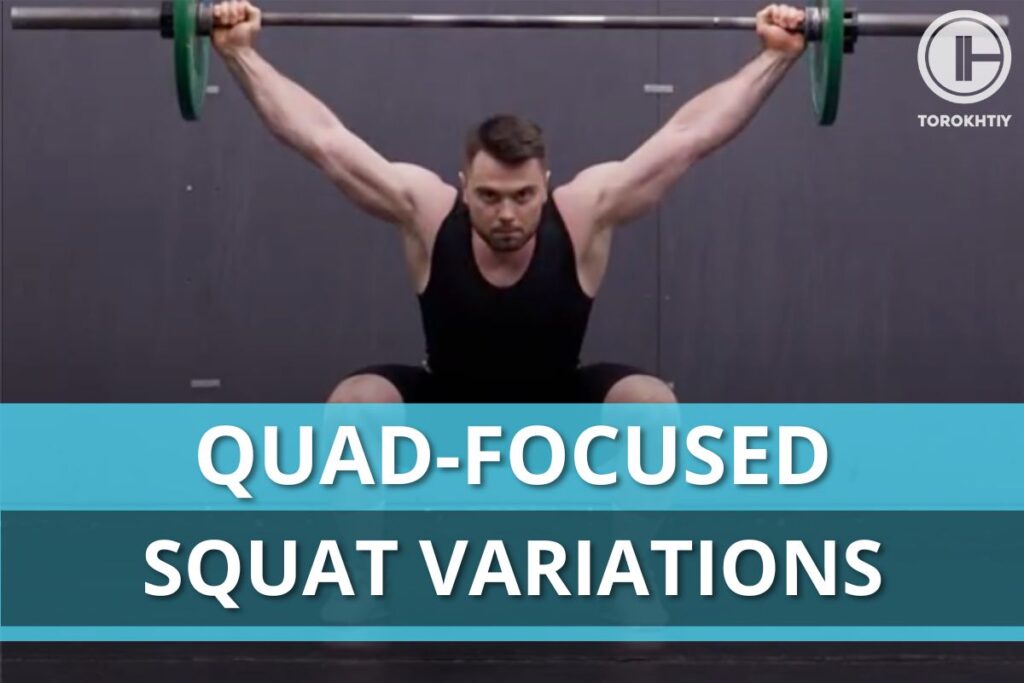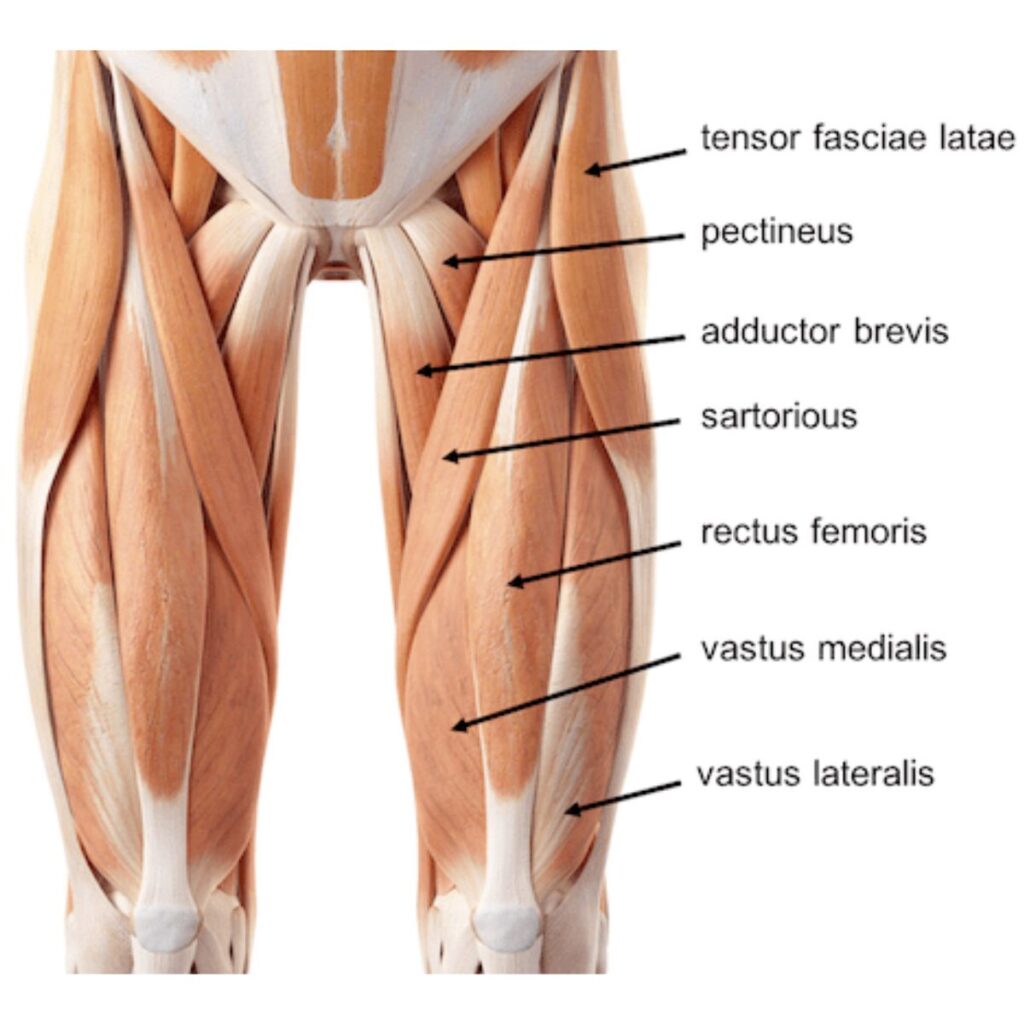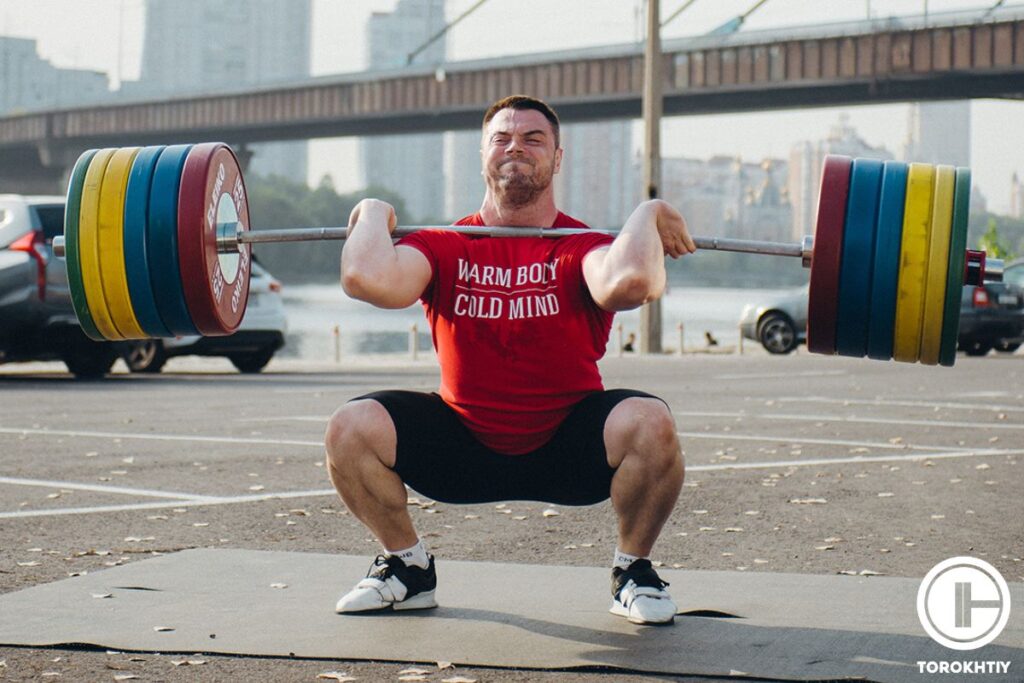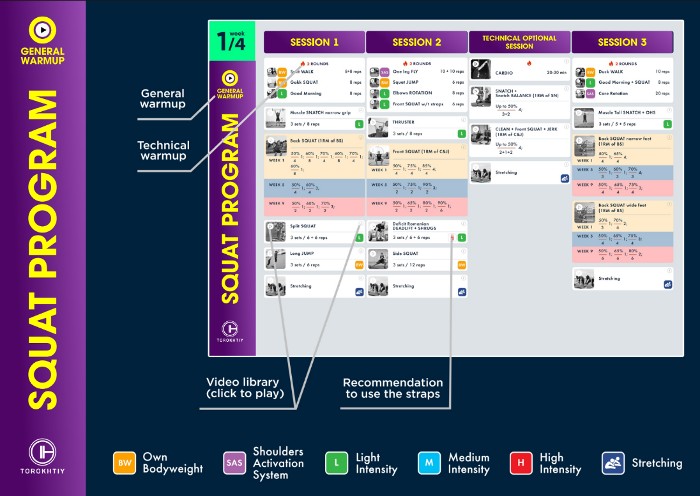5 Quad-Focused Squat Variations for Strength & Size
Author:
Reviewed by:
(21 years of Oly Lifting experience)
Unlock your full potential by engaging with our experts and community! Have questions about your fitness journey or looking for expert advice on weightlifting techniques? Don’t hesitate — leave a comment below and Jacek Szymanowski will provide a personalized answer and insights to help you reach your goals.
Torokhtiy is reader-supported. Some links are affiliate links, and we may earn a commission at no extra cost to you. See our disclosure page for details.
The standard squat involves moving from a standing position to a squat. Your feet stay flat on the floor and your thighs are hopefully at least parallel to the floor. Adding weights makes it harder and better for strengthening muscles and bones.
Squats target your quads, glutes, back muscles and calves, abductors, and your hamstrings. The degree in which they target each muscle depends on the type of squat you do.
If you’re looking to strengthen your quads then you need to read this guide to quad-focused squat variations.
Do Quad-Focused Squat Variations Work? Absolutely. Quad-focused squat variations will strengthen your legs and specifically your quads. However, like any type of exercise, you need to be consistent, it takes time to see results. With perseverance, the results can be impressive.

What Are Quads And How Do They Work In Squats?
The quads are a large group of muscles located in the front of your thighs. They are made up of four muscles, generally referred to as the heads.
These are:
- Rectus femoris
This is located in the middle of your thigh and covers most of the other three muscles. - Vastus lateralis
This muscle sits on the outer side of your thigh. - Vastus intermedius
The vastus intermedius sits on the inside of your thigh. - Vastus medialis
This one sits at the front of your thigh, sandwiched between the vastus lateralis and the vastus intermedius.

Your quads allow you to extend your leg from the knee, stabilize the knee, and flex your thigh. They are essential when walking, running, jumping, and even kicking.
In short, you need them in daily life, especially as you age and muscle mass starts to decrease.
During the squat, you need strong quad muscles to help to control your descent. This is primarily due to the phases of muscle movement, concentric (shortening of your muscles, which happens when you rise out of the squat) and eccentric (lengthening your muscles, as you lower into the squat). Weak quads will cause you to drop too quickly, losing tension and potentially causing an injury. That’s why you need quad-focused squats and should increase the weight of the barbell slowly.
Follow us!

Free!
Get a 2-week Weightlifting Program as a bonus for the subscription to kickstart your training plan!

Free!
Main Factors That Make Quads Work More In Squat
Squats for quads need to be part of your workout if you want to strengthen your body and your ability to perform many exercises.
The standard squat will work your quads. However, if you’re looking for the best squat form for quads you’ll need to start thinking about moving your weight forward – like front squat. Squats that target quads tend to make you focus on your weight being closer to the front of your foot.

This shifts your center of balance, making the quads work harder. There are several techniques you can use to help engage the quad more during your squat:
- Allow your knees to move further over your toes than normal
- Focus on engaging your quads throughout the movement
- Slow it down: effectively keeping tension on the quads for longer
- Push your big toe into the ground as you squat
- Choose one of the quad-focused squat variations
🔻GET A FREE PROGRAM DEMO: 12 Week Squat Program by Oleksiy Torokhtiy

Do you want to double your squat strength? In just 12 weeks, you’ll be able to boost your squat results.
Enter your details and get a free demo (1 free week) of the squat program straight into your inbox.
5 Best Squat Variations For Quads
Ready to discover the best squats for quads? You should try the following squat variations for quads and include some of these variations in your weekly workouts.
1. Front Squat
If you’re looking for squats for quads then start with the front squat. Most people choose the back squat, it feels more natural with the bar resting at the top of your back.
The front squat places the bar at the top of your chest and moves your center of the gravity forward. Studies show this increases the load on your quads.
Simply place the bar across the top of your shoulders, your elbows should jut out in front of you. Then slowly descend into the squat like normal.
If it’s your first time doing a front squat then use a lower weight than you use for the back squat. It will feel different and you want to get the form right.
2. Narrow Squat
The standard squat places your feet roughly in line with your hips. However, if you want the best squat stance for quads it’s time to move your feet closer together. This simple change puts you in position for one of the best squats for quads.
The narrow squat involves moving your feet closer together. The barbell is still in the classic back squat position.
As you descend into the squat you’ll feel it working your quads more and there will be less strain on your glutes and other leg muscles.
If you don’t feel comfortable moving your feet next to each other to squat, change position slowly, bringing your feet slightly closer together each time you do the exercise.
Again, you’ll need to try this with less weight than your standard back squat.
The narrow squat may sometimes be helpful if you struggle with limited hip mobility.
3. Heels elevated Squat
In this exercise we can get benefits of the front squat without holding the bar in the front, so if you are limited in your shoulder mobility ( internal rotation specifically) this one can be a good choice. Elevating your heels can be a good option if you want to go deeper with your squat but your ankle mobility is not the best and does not allow you to do so now.
You’ll want to place the barbell high on your back and your feet narrower than a standard squat. This tests your balance and makes you work your core as you squat.
Before you start, you’ll also need to put something under your heels. Weight plates are a simple way to do this. Elevating your heels forces the weight forward and allows you to squat deeper. The result is greater activation of the quads.
Again, start with lighter weights than usual.
4. Spanish Squat
This squat is designed to add load to your quads without stressing your knees. In fact, it’s often used as a rehabilitation exercise for injuries such as jumper’s knee.
Instead of using weights, you’ll need a resistance band. It goes around the back of your knees or upper calf and you’ll need to secure it to something solid, such as a squat rack.
You then perform a standard squat, the band will help you sit further back, this allows your shins to remain vertical, reducing the strain on your knees.
The first time you do these, complete them as a bodyweight exercise. Once you’re comfortable with the form you can add weights, usually in the form of a kettlebell in front of you. Try slow tempo and let your quads burn.
5. Bulgarian Split Squat
One of the best squats that target quads is the Bulgarian split squat. It also targets your hamstrings and glutes.
It’s best to use dumbbells when doing this squat. Simply hold one in one or each hand, with your arms straight by your side. You’ll need a raised surface, such as a weights bench or few plates, just behind you. Place one foot on this. Your other leg is in the standard squat starting position.
Now shift your body slightly forward to put more emphasis on the front leg, slowly lower yourself down into the squat and back up. Your quad will need to work for the entire movement, even when you’re standing. That’s what makes it an effective quad strengthener.
Again, start with a lower weight and focus on form, you may not go that low on your first attempt.
Provided you’re doing this with dumbbells, the Bulgarian split squat doesn’t place as much stress on your back as back squat.
FAQ
Why are my squats not hitting my quads?
You’ve either not adapted to the right squat form for quads or you’re not completing your squat properly.
Try one, or all, of the squat variations for quads above. Lower your normal weight and focus on form. You’ll feel it in your quads. Then, it’s just regular practice to see results.
Alternatively, your quads may already be much stronger than the other muscles involved in the squat. If this is the case, you’ll want to focus on the weakest muscle instead of your quads.
How do I squat more quad-focused?
You need to use the tips and variants in this article. In essence, you’ll want to focus on tensing your quads while squatting, moving your weight forward and/or elevating your heels.
Alongside this, slow the movement down to increase tension time. Remember, it takes perseverance to see changes in your muscle mass.
Conclusion
The squat is an excellent leg-strengthening exercise. The above quad-focused squat variations will improve the strength of your quads and the surrounding muscles. It will give you better balance, core stability, and flexibility. All of which are important in sports and aging.
Try the above variations today and let us know how you did!
Also Read:
- Why Do My Legs Shake When I Squat?
- Why Do My Legs Hurt So Much After I Do Squats?
- 5 Best Squat Alternatives For Bad Knees
- Squatting With Long Femurs: Tips For Lifters With Long Legs
- Squat and Deadlift Same Day: Right or Wrong?
- Leg Exercises For Bad Knees: Strengthening Your Legs Safely
- Do Squats Make Your Butt Bigger? (Improve The Result)
- How to Breathe During Squats? Techniques and Exercises
References:
- Hong, A. R., & Kim, S. W. (2018). Effects of Resistance Exercise on Bone Health. Endocrinology and Metabolism, 33(4), 435-444. https://doi.org/10.3803/EnM.2018.33.4.435
- Waligora, A. C., Johanson, N. A., & Hirsch, B. E. (2009). Clinical Anatomy of the Quadriceps Femoris and Extensor Apparatus of the Knee. Clinical Orthopaedics and Related Research, 467(12), 3297-3306. https://doi.org/10.1007/s11999-009-1052-y
- Shur, N. F., Creedon, L., Skirrow, S., Atherton, P. J., MacDonald, I. A., Lund, J., & Greenhaff, P. L. (2021). Age-related changes in muscle architecture and metabolism in humans: The likely contribution of physical inactivity to age-related functional decline. Ageing Research Reviews, 68. https://doi.org/10.1016/j.arr.2021.101344
- Pereira PEA, Motoyama YL, Esteves GJ, et al. Resistance training with slow speed of movement is better for hypertrophy and muscle strength gains than fast speed of movement. Int J Appl Exerc Physiol. 2016;5(2):37–43.
- BAUTISTA, D., DURKE, D., COTTER, J. A., ESCOBAR, K. A., & SCHICK, E. E. (2020). A Comparison of Muscle Activation Among the Front Squat, Overhead Squat, Back Extension and Plank. International Journal of Exercise Science, 13(1), 714-722. https://www.ncbi.nlm.nih.gov/pmc/articles/PMC7241624/
- All photos are made by our Torokhtiy Media Team
Why Trust Us?
With over 20 years in Olympic weightlifting, strength training, nutrition coaching, and general fitness our team does its best to provide the audience with ultimate support and meet the needs and requirements of advanced athletes and professional lifters, as well as people who strive to open new opportunities and develop their physical capabilities with us.
By trusting the recommendations of our certified experts in coaching, nutrition, and sports training programming, as well as scientific consultants, and physiotherapists, we provide you with thorough, well-considered, and scientifically proven content. All the information given in the articles concerning workout programming, separate exercises, and athletic performance, in general, is based on verified data.
The product testing process is described in more detail here.
Author: Jacek Szymanowski
Certified Nutritionist,
M.Sc.Eng. Biotechnology
Performance Architect,
Strength and Conditioning Specialist
With over 30 years of fighting experience, specialization in nutrition coaching for athletes, and expertise in metabolic health and dietary strategies, Jacek offers a comprehensive approach to optimizing your performance and well-being. Backed by a Master of Science degree in Biotechnology, Jacek remains at the forefront of scientific advancements, ensuring that his coaching is always evidence-based and up-to-date.
Reviewed by: Oleksiy Torokhtiy
Olympic Weightlifting Champion, PhD in Sport Science
Best Results: Snatch – 200 kg,
C&J – 240 kg
Oleksiy Torokhtiy is a professional athlete boasting 20 years of experience in Olympic weightlifting. With multiple European and World titles under his belt, he has showcased his prowess in two Olympic Games (Beijing 2008 and London 2012). Upon concluding his illustrious career, Oleksiy dedicated himself to coaching. By 2022, he had conducted over 200 weightlifting seminars worldwide. He is the visionary behind an international sportswear and accessories brand known for its motto, “Warm Body Cold Mind.” Additionally, he is an esteemed author and the creator of a series of training programs and eBooks.




Still have questions after reading our article? Unlock your full potential by engaging with our experts and community! Don’t hesitate — leave a comment below and Jacek Szymanowski will provide a personalized answer and insights to help you reach your goals.